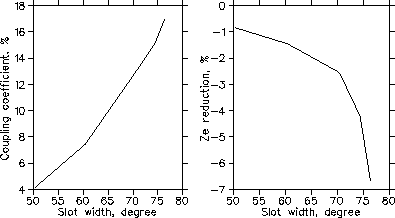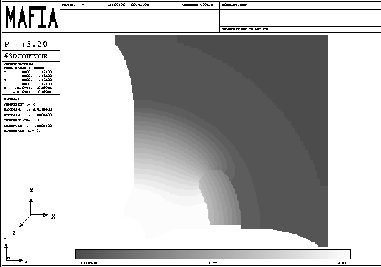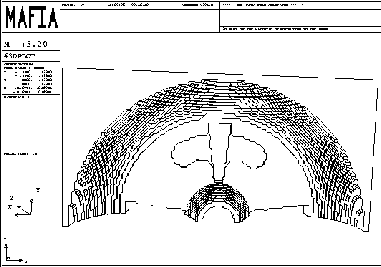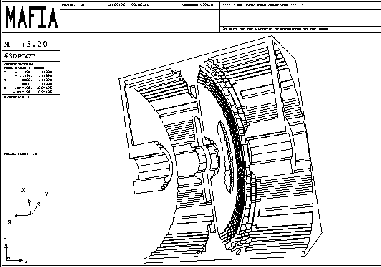L.V. Kravchuk, V.V. Paramonov
Institute for Nuclear Research of the RAS, 117312, Moscow, Russia
The On-axis Coupled Structure (OCS) has been optimized for applications
in proton linacs with moderate heat loading to the accelerating structure.
Without interior cooling of the cells the total length of the coupling cell
together with webs between cells may be done relatively small.
This case the coupling constant for OCS also may be strongly increased.
With the numerical 3D optimization of coupling slot dimensions, shape and
position it was shown, that coupling constant may be increased up to
![]() with tolerable
with tolerable ![]() reduction (due to coupling slots) in
shunt impedance. For low energy region (
reduction (due to coupling slots) in
shunt impedance. For low energy region ( ![]() ) the shunt
impedance and accelerating gradient of the OCS may be improved with
introduction of additional intermediate drift tube (OCSDTL option), keeping
coupling constant up to
) the shunt
impedance and accelerating gradient of the OCS may be improved with
introduction of additional intermediate drift tube (OCSDTL option), keeping
coupling constant up to ![]() . The ideas, restrictions and results of
the structure optimization are presented.
. The ideas, restrictions and results of
the structure optimization are presented.
The optimized OCS version has the
shunt impedance not less than another Coupled Cells (CC) structures and
combines
it with increased value of the coupling constant and the simple design.
After the Side-Coupled Structure (SCS), the OCS
with magnetic coupling (due to coupling slots in the webs between cells)
is now at second place in the usage in particle accelerators.
This structure was applied for
linac in the Advanced Free-Electron Laser Initiative at Los Alamos
with high gradients (to 22 MeV/m), high peak-power klystron (20 MW) and
up to 50-ms long macro pulses [1]. For cw operation with heavy heat
loading this structure is
used in Mainz [2] and INP MSU [3] race-track microtrons.
The structure also was investigated in details, both theoretically and
experimentally [4], for the set of small electron linacs for
industrial applications.
The benefit OSC features are very simple design and small transverse
dimensions.
The optimization of the OCS for applications in proton linacs has been
performed, providing good results in the structure parameters.
The electron linacs, for which OCS was considered before, usually
operate in S-band, with operating wavelength ![]() .
The requirements of mechanical strength and heat conductivity from
the central region to outer one (to cooling channels) lead to relatively
thick web, limiting the coupling constant
.
The requirements of mechanical strength and heat conductivity from
the central region to outer one (to cooling channels) lead to relatively
thick web, limiting the coupling constant ![]() to
to ![]() .
Total distance
.
Total distance ![]() , where
, where ![]() is the coupling
cell length, t - web thickness, takes essential part of the structure
period, leading to smaller, (in comparison with another CC structures) value
of the effective shunt impedance
is the coupling
cell length, t - web thickness, takes essential part of the structure
period, leading to smaller, (in comparison with another CC structures) value
of the effective shunt impedance ![]() .
.
The theoretical background for the structure optimization in details is
presented in [5], below application to OSC is shortly described.
In our optimization of the OCS for proton linacs,
with operating wavelength ![]() ,
we do not do direct scaling of the cells
dimensions from "electron OCS" version. First of all, decision has been done
to have no cooling channels in webs of "proton OCS". This case we can restrict
the web thickness with the value
,
we do not do direct scaling of the cells
dimensions from "electron OCS" version. First of all, decision has been done
to have no cooling channels in webs of "proton OCS". This case we can restrict
the web thickness with the value ![]() , limiting only with mechanical
constrains. The length
, limiting only with mechanical
constrains. The length ![]() also should
be as small as possible, but one have to take into account two restrictions.
also should
be as small as possible, but one have to take into account two restrictions.
First one is the detuning of coupling cells. It is known well, coupling slots
reduce own frequencies both accelerating and coupling cells. One can show
that detuning
value ![]() . Reduction in the frequency must be compensated by
reduction of the cell radius
. Reduction in the frequency must be compensated by
reduction of the cell radius ![]() , and for small values
, and for small values ![]() becomes
less than radius
becomes
less than radius ![]() for optimal position of coupling slots.
for optimal position of coupling slots.
Second restriction
relates with sparking in coupling cells. Sparking in the structure may take
place both in accelerating and in coupling cells [5]. In steady-state
regime coupling cells do excite with very low
level to provide rf power flux along the structure for compensations of rf
losses. Strong excitations
of coupling cells takes place during transient, in the initial time period
![]() :
:
where L and N are the length and number of the structure periods from the
rf input point to the end, ![]() - the group velocity, c - speed of light,
- the group velocity, c - speed of light,
![]() - operating frequency and
- operating frequency and ![]() - relative velocity of protons.
During this time period, maximum electric field at the surface of
coupling cell
- relative velocity of protons.
During this time period, maximum electric field at the surface of
coupling cell ![]() may be high enough [5],
leading to sparking in coupling cells [6].
may be high enough [5],
leading to sparking in coupling cells [6]. ![]() depends on
shape, dimensions of coupling cell and another parameters of the accelerating
structure.
Comparing accelerating structures of existing proton accelerators,
we have founded, that SCS structure at FNAL Linac Upgrade [6] operates
with maximum value
depends on
shape, dimensions of coupling cell and another parameters of the accelerating
structure.
Comparing accelerating structures of existing proton accelerators,
we have founded, that SCS structure at FNAL Linac Upgrade [6] operates
with maximum value ![]() during transient, according (2). Referring
to FNAL Linac Upgrade successful operation, we have limited
during transient, according (2). Referring
to FNAL Linac Upgrade successful operation, we have limited ![]() for OCS with FNAL SCS
for OCS with FNAL SCS ![]() value.
value.
In the OCS
structure ![]() is large at two points - at the lower edge of the
coupling slot and near bore hole. To decrease
is large at two points - at the lower edge of the
coupling slot and near bore hole. To decrease ![]() value,
coupling slots and coupling cell bore hole must be rounded with radius not
less than t/2.0.
value,
coupling slots and coupling cell bore hole must be rounded with radius not
less than t/2.0.
Taking into account reasons above we have chosen ![]() .
.
The shape and dimensions of the accelerating cells for OCS were optimized
for DESY Linac 3 Upgrade proposal [7] in 2D approximation, by using set
of 2D codes [8]. For the same beam hole radius
a=15 mm, operating frequency and ![]() , 2D calculated
effective shunt impedance
, 2D calculated
effective shunt impedance ![]() for OCS is less than 2D
for OCS is less than 2D ![]() for FNAL SCS
at
for FNAL SCS
at ![]() for
for ![]() and at
and at ![]() for
for ![]() . The total
thickness
. The total
thickness ![]() remains larger than web thickness 7.5 mm
in SCS FNAL design.
remains larger than web thickness 7.5 mm
in SCS FNAL design.


The coupling slots investigation, optimization and choice was performed
using MAFIA code.
There are two coupling slots at each web between
accelerating and coupling cells. Mutual orientation of coupling slots
is important for ![]() value. To increase
value. To increase ![]() by canceling mutual
influence, slots position is rotated at
by canceling mutual
influence, slots position is rotated at ![]() in webs of coupling cell.
The difference between
in webs of coupling cell.
The difference between ![]() values for rotated and slot-to-slot orientation
in short coupling cell is more than 2.5 times. Orientation of coupling
slots at
opposite webs of accelerating cells practically do not influences
for
values for rotated and slot-to-slot orientation
in short coupling cell is more than 2.5 times. Orientation of coupling
slots at
opposite webs of accelerating cells practically do not influences
for ![]() . Only frequency of coupling cell changes approximately at
. Only frequency of coupling cell changes approximately at ![]() ,
because field of coupling cell significantly penetrates into accelerating one.
The mutual orientation of coupling slots in accelerating cell strongly
defines quadrupole distortions in the accelerating field distribution.
To reduce this distortion, we accept slot-to-slot
orientation for accelerating cells.
,
because field of coupling cell significantly penetrates into accelerating one.
The mutual orientation of coupling slots in accelerating cell strongly
defines quadrupole distortions in the accelerating field distribution.
To reduce this distortion, we accept slot-to-slot
orientation for accelerating cells.
The radial position of slots is chosen near the half of the accelerating
cell radius.
It is known, that rise of ![]() by slot length increasing all time
assists with reduction in
by slot length increasing all time
assists with reduction in ![]() . The coupling slots provide perturbation
for rf current distribution in accelerating cell. The maximum value of rf
current density
. The coupling slots provide perturbation
for rf current distribution in accelerating cell. The maximum value of rf
current density ![]() takes place at the ends of slots, the minimum one
takes place at the ends of slots, the minimum one
![]() - in the middle of the slot. To provide the high
- in the middle of the slot. To provide the high ![]() value with
small reduction in
value with
small reduction in ![]() the coupling slots are chosen wide enough.
Total set of decisions in the structure optimization leads to the tolerable
reduction of
the coupling slots are chosen wide enough.
Total set of decisions in the structure optimization leads to the tolerable
reduction of ![]() even for significant values of
even for significant values of ![]() (Fig.2).
(Fig.2).
As the result of the OCS optimization we have the option with ![]() and
and ![]() reduction due to coupling slots
reduction due to coupling slots ![]() for
for
![]() and
and ![]() for
for ![]() . Because the distance
. Because the distance
![]() is fixed, with the same slots opening
is fixed, with the same slots opening ![]() decreases for higher
decreases for higher
![]() . To compensate this decreasing one need increase opening, providing
larger reduction in in
. To compensate this decreasing one need increase opening, providing
larger reduction in in ![]() . Maximum values of
. Maximum values of ![]() were founded in this
research
were founded in this
research ![]() for
for ![]() and
and ![]() for
for ![]() .
.
Comparing calculated 3D ![]() values for proposed OCS and FNAL SCS, one will
have practically the same numbers (differing in units of
values for proposed OCS and FNAL SCS, one will
have practically the same numbers (differing in units of ![]() ) but with
) but with
![]() for OCS.
for OCS.
In this OCS proposal coupling cells are heavy loaded with coupling slots (see
Fig. 1), but accelerating cells are not. The problem of high coupling is
solved by coupling cells, without large perturbations in accelerating ones.

The temperature distribution in the OCS ( ![]() ) with one cooling
channel per period (see Fig. 1)
is shown at Fig. 3. (Special procedure has been developed to calculate
temperature distribution due to rf losses with MAFIA code.) For the heat
loading
) with one cooling
channel per period (see Fig. 1)
is shown at Fig. 3. (Special procedure has been developed to calculate
temperature distribution due to rf losses with MAFIA code.) For the heat
loading ![]() maximum
temperature difference (between drift tube nose and cooling channel) is
maximum
temperature difference (between drift tube nose and cooling channel) is
![]() . This value of the heat loading is comparable with that one for
existing "meson facility" linacs and do not provide difficulties for
existing frequency control systems.
Maximum of the temperature gradient and associated
thermal stresses take place at radius of slots position and with wide slots
are not dangerous for stable longtime operation.
. This value of the heat loading is comparable with that one for
existing "meson facility" linacs and do not provide difficulties for
existing frequency control systems.
Maximum of the temperature gradient and associated
thermal stresses take place at radius of slots position and with wide slots
are not dangerous for stable longtime operation.

The vacuum conductivity may be strongly improved by
additional radial slots in webs (Fig. 4). Two of these radial slots cross
coupling slots in the middle, two another are placed between coupling slots.
So, four additional radial slot in each web provide four channels through
the structure from one end to another. With small angle opening (not more
than ![]() ), radial slots are not resonant elements and do not interferer
significantly the field distribution in accelerating cells.
To keep
), radial slots are not resonant elements and do not interferer
significantly the field distribution in accelerating cells.
To keep ![]() limited, the cross of the radial slot with lower
edge of the coupling one should be rounded.
limited, the cross of the radial slot with lower
edge of the coupling one should be rounded.
It is known well, that efficiency of all CC structures decreases
with decreasing ![]() . Very powerful solution was proposed
[9]and tested with the SCS to avoid this disadvantage and to combine the
efficiency of the Drift Tube structure with stability properties of CC
structures by introducing Intermediate Drift Tubes (IDT). The length of
the period d' this case is
. Very powerful solution was proposed
[9]and tested with the SCS to avoid this disadvantage and to combine the
efficiency of the Drift Tube structure with stability properties of CC
structures by introducing Intermediate Drift Tubes (IDT). The length of
the period d' this case is ![]() , where n is the number
of IDT. This solution can be applied to OCS (Fig.5). Because d' becomes
large, coupling cell together with webs take a small relative part and
do not lead to significant reduction of 2D
, where n is the number
of IDT. This solution can be applied to OCS (Fig.5). Because d' becomes
large, coupling cell together with webs take a small relative part and
do not lead to significant reduction of 2D ![]() .
All improvements and problems, related with IDT, are the same as for
SCS, except one.
.
All improvements and problems, related with IDT, are the same as for
SCS, except one.
For all CC structures introduction of
IDT leads to
redistribution of magnetic field for accelerating mode. Maximum of the
magnetic field take place near IDT. Together with
increasing of the accelerating cells volume, it leads to
decreasing of the ![]() value. In OCSDTL version we can, by
increasing of the slots opening to
value. In OCSDTL version we can, by
increasing of the slots opening to ![]() , keep coupling constant at
, keep coupling constant at
![]() for
for ![]() value with the same
value with the same ![]() reduction in
reduction in ![]() .
Because in estimations [5] of coupling cells excitation
.
Because in estimations [5] of coupling cells excitation ![]() and
and ![]() should be transformed for CCDTL into
should be transformed for CCDTL into
![]() ,
the OCSDTL option looks to be more
strong against possible sparking in coupling cells.
,
the OCSDTL option looks to be more
strong against possible sparking in coupling cells.
The optimization of coupling cells and coupling slots leads to attractive characteristics of the OCS for application in proton linacs. Combining the simple design, improved coupling constant and high shunt impedance, the structure can, after high power test, provide strong competition to another candidates for application in proton linacs with moderate heat loading.

The authors thank N.Holtkamp (DESY), S.K. Esin, P.N. Ostroumov, V.L. Serov (INR) for fruitful discussions, and DESY for providing good conditions for this work.